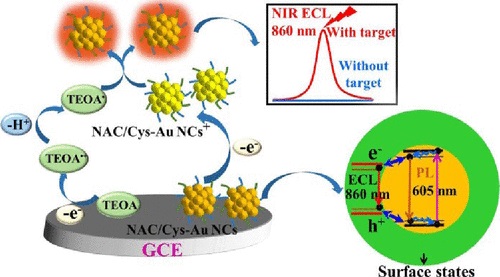Electrochemiluminescence
Principles Electrochemiluminescence method (ECL)
Electrochemiluminescence is a process that occurs through several molecules, including ruthenium compounds (Ru), osmium, rhenium, or other known elements. The electrochemical process of luminescence causes the production of stable precursors on the surface of the electrode, and the final product of this reaction is the production of light. The basis of ECL is in the use of ruthenium tris bipyridyl complex “+2[bpy3 RU] and tripropylamine (TPA), the final product of which can be measured as light. The reaction is initiated by electric current, which will eventually lead to the production of light from the tris ruthenium complex. In this step, an electric voltage is applied to the ruthenium tris immunological complex, which is attached to the streptavidin coated on the surface of the microparticles. The use of electric reaction is one of the advantages of this method, which can control the entire reaction.
Components involved in ECL method
For better understanding, we will explain the components involved in an ECL reaction. These components include streptoavidin, biotin, analyte (or antigen), antibody, microparticle, ruthenium and triplopilamine. If it is assumed that the unknown analyte is an antigen, ruthenium is attached to an antibody that has the ability to bind to the unknown antigen, and on the other hand, biotin is mounted on another antibody that has the ability to bind to another epitope of the unknown antigen, which is called It is called biotinylated antibody. Biotin and streptoavidin have a strong tendency to bind to each other. Microparticles whose surface is covered with streptavidin are added to the reaction. During the incubation period, a complex is formed that has microparticles at one end and ruthenium at the other end. To stabilize this complex, a magnetic field is used, which will connect the microparticles to the metal solid surface. After stabilization, the reaction between triplopilamine (which actually acts as a catalyst) and ruthenium (which acts as a light emitter) starts by applying an electric voltage, which eventually leads to the production of light. The resulting light is sent to a detector using a light amplifier (photomultiplier or PMT) and the amount of emitted photons is measured.
Components involved in ECL method
For better understanding, we will explain the components involved in an ECL reaction. These components include streptoavidin, biotin, analyte (or antigen), antibody, microparticle, ruthenium and triplopilamine. If it is assumed that the unknown analyte is an antigen, ruthenium is attached to an antibody that has the ability to bind to the unknown antigen, and on the other hand, biotin is mounted on another antibody that has the ability to bind to another epitope of the unknown antigen, which is called It is called biotinylated antibody. Biotin and streptoavidin have a strong tendency to bind to each other. Microparticles whose surface is covered with streptavidin are added to the reaction. During the incubation period, a complex is formed that has microparticles at one end and ruthenium at the other end. To stabilize this complex, a magnetic field is used, which will connect the microparticles to the metal solid surface. After stabilization, the reaction between triplopilamine (which actually acts as a catalyst) and ruthenium (which acts as a light emitter) starts by applying an electric voltage, which eventually leads to the production of light. The resulting light is sent to a detector using a light amplifier (photomultiplier or PMT) and the amount of emitted photons is measured.
مزایای استفاده از دستگاه ECL برند Lifotronic
- Full automation of the device that completely eliminates technical (pre-analytical) error.
- It has very stable and easy-to-use reagents with a long history.
- Kit, calibrator and control integrated in a single package.
- High sensitivity to measure analytes with very small amounts and also in a short period of time.
- Correct and accurate answer
Comprehensive menu test
Very high reproducibility makes it unnecessary to repeat tests, thus reducing costs. - Two-way connection to the network (elimination of pre- and post-analytical errors)
Very easy to use
Small dimensions compared to the performance of the device
Comparison of electroluminescence quantitative method with ELISA and luminescence quantitative method
In the ELISA method, antibodies are labeled with radioactive substances and finally the intensity of the created color is measured. In the luminescence quantitative method, the intensity of light from the excited product of a chemical reaction, when it returns to the base level, due to the inability to control the location of the resulting light radiation and also the inability to control the limited time of this radiation, makes it difficult to determine the concentration. - In the luminescence electrochemical method, a platinum electrode is added to the system, which concent
rates the light at the detector location and prevents its dispersion. This electrode also adjusts the
time range of the reaction, so that when the electric current is established, the light production rea
ction begins and ends when the reaction stops. Another feature of this new system is the ability to measu
re several different analytes at the same time in the test sample.

